Welcome to the fascinating world of conic sections! In this lesson, we’ll dive deep into one of the most fundamental shapes: the parabola. Understanding parabolas is crucial in mathematics, as they appear in various applications, from physics and engineering to art and architecture. Our Conic Sections journey begins here, and by the end of this lesson, you’ll have a solid grasp of what a parabola is, its properties, and how to work with it.
Table of Contents
Now, in this guide, we’ll be concentrating on Conic Sections Parabolas. We’ll examine their properties, how to recognize them, and, perhaps most importantly, how to work with them. So, whether you’re a student, a curious mind, or someone brushing up on their math skills, get ready to unravel the secrets of parabolas and their role in the broader family of conic sections.
What are Conic Sections?
Before we focus on parabolas, let’s briefly introduce conic sections. A conic section is a curve formed by the intersection of a plane and a cone. The type of curve formed depends on the angle at which the plane intersects the cone. There are four main types of conic sections:
- Parabola: Formed when the plane intersects the cone parallel to one of its sides.
- Ellipse: Formed when the plane intersects the cone at an angle, but not parallel to the side. A circle is a special case of an ellipse.
- Hyperbola: Formed when the plane intersects both halves of the cone.
- Circle: A special case of an ellipse, formed when the plane intersects the cone perpendicularly to its axis.
In this lesson, we’ll concentrate on parabolas. The other conic sections will be explored in subsequent lessons.
Defining a Parabola
A parabola is defined as the set of all points in a plane that are equidistant from a fixed point (called the focus) and a fixed line (called the directrix). Let’s break this down:
- Focus: A fixed point inside the parabola.
- Directrix: A fixed line outside the parabola.
- Vertex: The point on the parabola that is closest to the directrix. It lies exactly halfway between the focus and the directrix.
Imagine a point moving in a plane. For it to trace a parabola, the distance from this point to the focus must always be equal to its distance from the directrix. This constant distance relationship is the defining characteristic of a parabola.
Standard Equations of a Parabola
The equation of a parabola depends on its orientation (whether it opens upwards, downwards, leftwards, or rightwards) and the location of its vertex. Let’s explore the standard forms:
1. Parabola Opening Upwards or Downwards
When a parabola opens upwards or downwards, its equation takes the form:
### (x – h)^2 = 4p(y – k) ###Where:
- (h, k) is the vertex of the parabola.
- ‘p’ is the distance from the vertex to the focus, and also the distance from the vertex to the directrix.
- If p > 0, the parabola opens upwards.
- If p < 0, the parabola opens downwards.
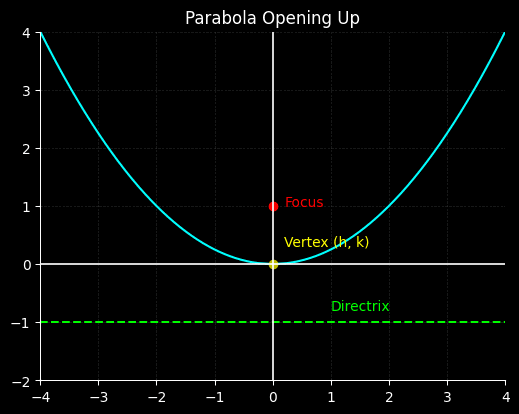
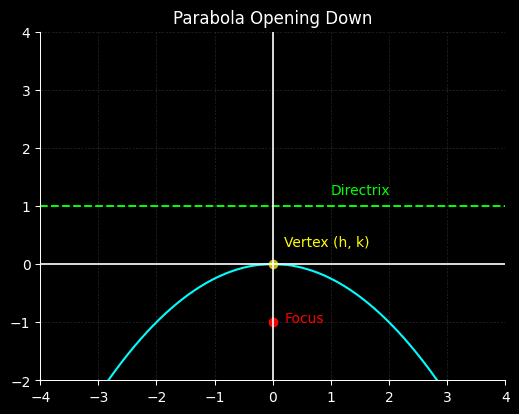
Example 1: Consider the equation ##(x – 2)^2 = 8(y – 1)##. Here, the vertex is at (2, 1). Since 4p = 8, we have p = 2. This means the focus is 2 units above the vertex, at (2, 3), and the directrix is the horizontal line y = -1.
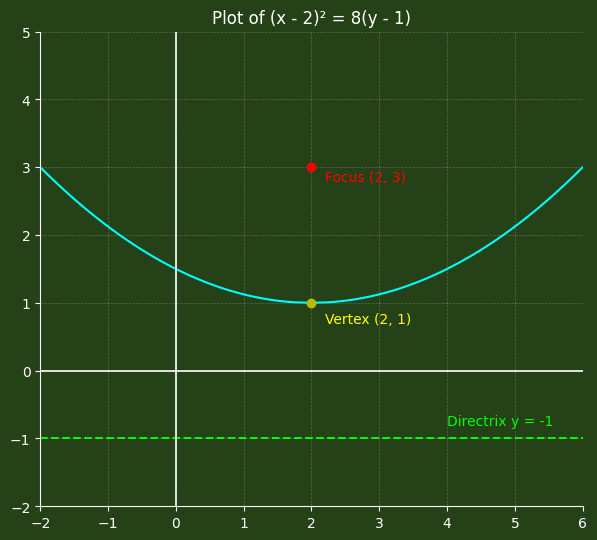
Example 2: For the equation ##(x + 1)^2 = -4(y – 3)##, the vertex is at (-1, 3). Since 4p = -4, we have p = -1. The focus is 1 unit below the vertex, at (-1, 2), and the directrix is the horizontal line y = 4. The parabola opens downwards.

2. Parabola Opening Leftwards or Rightwards
When a parabola opens leftwards or rightwards, its equation takes the form:
### (y – k)^2 = 4p(x – h) ###Where:
- (h, k) is the vertex of the parabola.
- ‘p’ is the distance from the vertex to the focus, and also the distance from the vertex to the directrix.
- If p > 0, the parabola opens rightwards.
- If p < 0, the parabola opens leftwards.
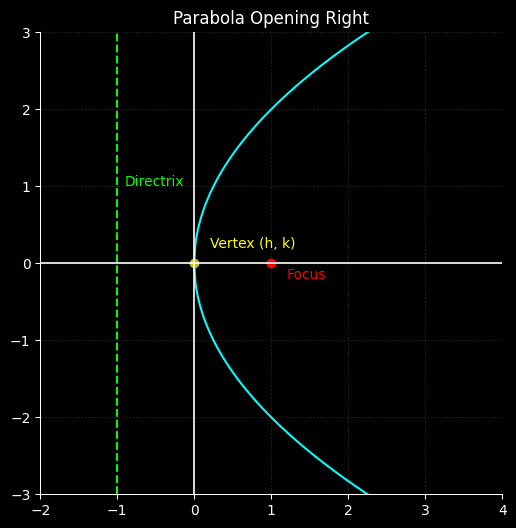

Example 3: Consider the equation ##(y – 3)^2 = 12(x – 2)##. The vertex is at (2, 3). Since 4p = 12, we have p = 3. The focus is 3 units to the right of the vertex, at (5, 3), and the directrix is the vertical line x = -1.
Example 4: For the equation ##(y + 2)^2 = -8(x + 1)##, the vertex is at (-1, -2). Since 4p = -8, we have p = -2. The focus is 2 units to the left of the vertex, at (-3, -2), and the directrix is the vertical line x = 1. The parabola opens leftwards.
Key Features of a Parabola
Let’s look at some important features of a parabola that help us understand and work with them:
- Vertex: The turning point of the parabola. It’s the point where the parabola changes direction.
- Focus: A point inside the parabola. All points on the parabola are equidistant from the focus and the directrix.
- Directrix: A line outside the parabola. All points on the parabola are equidistant from the focus and the directrix.
- Axis of Symmetry: A line that passes through the vertex and the focus. The parabola is symmetrical about this line.
- Latus Rectum: A line segment passing through the focus, perpendicular to the axis of symmetry, with endpoints on the parabola. Its length is equal to 4|p|. The latus rectum helps determine the width of the parabola at the focus.
Graphing Parabolas
Graphing parabolas involves identifying the vertex, focus, directrix, and axis of symmetry. Here’s a step-by-step approach:
- Identify the Vertex: Determine the coordinates (h, k) from the standard equation.
- Find ‘p’: Solve for ‘p’ using the equation ##4p = ## the coefficient of the linear term (either (y-k) or (x-h)).
- Determine the Directrix:
- If the parabola opens upwards or downwards: The directrix is the line y = k – p.
- If the parabola opens leftwards or rightwards: The directrix is the line x = h – p.
- Find the Axis of Symmetry:
- If the parabola opens upwards or downwards: The axis of symmetry is the line x = h.
- If the parabola opens leftwards or rightwards: The axis of symmetry is the line y = k.
- Determine the Focus:
- If the parabola opens upwards or downwards: The focus is at (h, k + p).
- If the parabola opens leftwards or rightwards: The focus is at (h + p, k).
- Find the Latus Rectum: The length of the latus rectum is ##4|p|##. This helps determine the width of the parabola at the focus. The endpoints of the latus rectum are useful for sketching the curve.
- Plot Points: Plot the vertex, focus, and a few additional points (you can find these by substituting values into the equation). Use the latus rectum to help determine the width.
- Sketch the Curve: Draw a smooth curve through the plotted points, keeping in mind the symmetry of the parabola.
Example 5: Graph the parabola ##(x – 1)^2 = 4(y + 2)##.

- Vertex: (1, -2)
- Find ‘p’: 4p = 4, so p = 1.
- Focus: (1, -2 + 1) = (1, -1)
- Directrix: y = -2 – 1, so y = -3
- Axis of Symmetry: x = 1
- Latus Rectum: 4|1| = 4. The endpoints of the latus rectum are 2 units to the left and right of the focus. So, the endpoints are at (-1, -1) and (3, -1).
- Plot Points and Sketch: Plot the vertex, focus, endpoints of the latus rectum, and draw a smooth curve.
Converting General Form to Standard Form
Sometimes, the equation of a parabola is given in general form, which is not as easy to analyze as the standard form. The general forms are:
- ##y = ax^2 + bx + c## (for parabolas opening upwards or downwards)
- ##x = ay^2 + by + c## (for parabolas opening leftwards or rightwards)
To graph a parabola in general form, we need to convert it to standard form by completing the square. Let’s see how this works:
Example 6: Convert ##y = x^2 – 4x + 7## to standard form and graph it.
- Complete the Square:
- Group the x terms: ##y = (x^2 – 4x) + 7##
- Take half of the coefficient of the x term (-4), square it (##(-2)^2 = 4##), and add and subtract it inside the parentheses: ##y = (x^2 – 4x + 4 – 4) + 7##
- Rewrite the perfect square trinomial: ##y = (x – 2)^2 – 4 + 7##
- Simplify: ##y = (x – 2)^2 + 3##
- Rewrite in standard form: ##(x – 2)^2 = y – 3## or ##(x – 2)^2 = 1(y – 3)##
- Identify the Vertex: (2, 3)
- Find ‘p’: 4p = 1, so p = 1/4.
- Focus: (2, 3 + 1/4) = (2, 13/4)
- Directrix: y = 3 – 1/4, so y = 11/4
- Axis of Symmetry: x = 2
- Latus Rectum: 4|1/4| = 1. The endpoints of the latus rectum are 1/2 units to the left and right of the focus. So, the endpoints are at (3/2, 13/4) and (5/2, 13/4).
- Plot Points and Sketch: Plot the vertex, focus, endpoints of the latus rectum, and draw a smooth curve.

Example 7: Convert ##x = 2y^2 + 8y + 5## to standard form and graph it.
- Complete the Square:
- Group the y terms: ##x = 2(y^2 + 4y) + 5##
- Factor out the coefficient of the ##y^2## term (2): ##x = 2(y^2 + 4y) + 5##
- Take half of the coefficient of the y term (4), square it (##2^2 = 4##), and add and subtract it inside the parentheses. Since we are adding inside the parentheses which is multiplied by 2, we subtract 2*4=8 outside the parentheses: ##x = 2(y^2 + 4y + 4 – 4) + 5##
- Rewrite the perfect square trinomial: ##x = 2(y + 2)^2 – 8 + 5##
- Simplify: ##x = 2(y + 2)^2 – 3##
- Rewrite in standard form: ##2(y + 2)^2 = x + 3## or ##(y + 2)^2 = \frac{1}{2}(x + 3)##
- Identify the Vertex: (-3, -2)
- Find ‘p’: 4p = 1/2, so p = 1/8.
- Focus: (-3 + 1/8, -2) = (-23/8, -2)
- Directrix: x = -3 – 1/8, so x = -25/8
- Axis of Symmetry: y = -2
- Latus Rectum: 4|1/8| = 1/2. The endpoints of the latus rectum are 1/4 units above and below the focus. So, the endpoints are at (-23/8, -15/8) and (-23/8, -17/8).
- Plot Points and Sketch: Plot the vertex, focus, endpoints of the latus rectum, and draw a smooth curve.
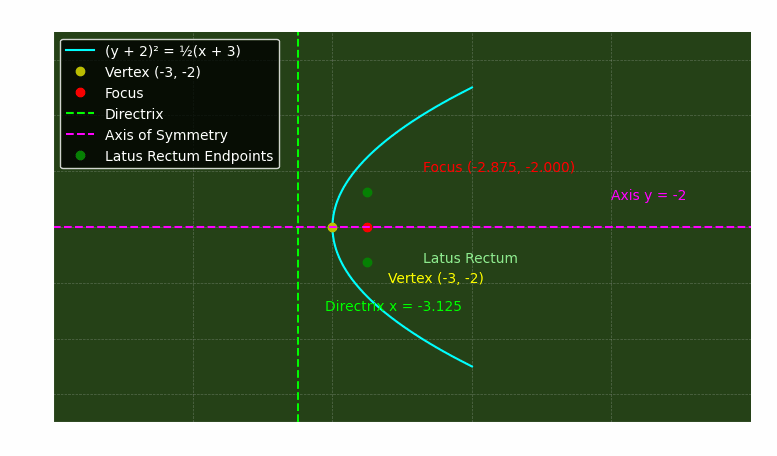
Applications of Parabolas
Parabolas have numerous real-world applications. Their unique reflective properties make them invaluable in various fields:
- Satellite Dishes: Satellite dishes are shaped like parabolas. They reflect incoming radio waves from satellites to a single point, the focus, where the receiver is located. This is a classic example of how the Conic Sections are used.
- Flashlights and Headlights: Flashlights and headlights use parabolic reflectors to focus light from a bulb (placed at the focus) into a parallel beam.
- Solar Cookers: Solar cookers use parabolic mirrors to concentrate sunlight onto a focal point, heating food.
- Suspension Bridges: The cables of suspension bridges often approximate parabolas.
- Projectile Motion: The path of a projectile (like a ball thrown in the air) follows a parabolic trajectory, neglecting air resistance.
Solving Problems Involving Parabolas
Let’s work through some more examples to solidify your understanding. These examples will demonstrate how to use the concepts we’ve learned to solve various problems related to parabolas.
Example 8: Find the equation of the parabola with vertex at (1, 2) and focus at (1, 4).
Solution:
- Determine the Orientation: Since the vertex and focus have the same x-coordinate, the parabola opens upwards.
- Find ‘p’: The distance between the vertex (1, 2) and the focus (1, 4) is 2 units. Therefore, p = 2.
- Use the Standard Equation: The standard equation for a parabola opening upwards is ##(x – h)^2 = 4p(y – k)##. Substitute the vertex (h, k) = (1, 2) and p = 2:
- ##(x – 1)^2 = 4(2)(y – 2)##
- Simplify: ##(x – 1)^2 = 8(y – 2)##
- Answer: The equation of the parabola is ##(x – 1)^2 = 8(y – 2)##.

Example 9: Find the vertex, focus, and directrix of the parabola ##y^2 – 6y – 4x + 1 = 0##.
Solution:
- Convert to Standard Form: Complete the square for the y terms:
- Rewrite the equation: ##y^2 – 6y = 4x – 1##
- Complete the square: ##y^2 – 6y + 9 = 4x – 1 + 9##
- Rewrite: ##(y – 3)^2 = 4x + 8##
- Simplify: ##(y – 3)^2 = 4(x + 2)##
- Identify the Vertex: The vertex is at (-2, 3).
- Find ‘p’: 4p = 4, so p = 1.
- Determine the Focus: Since the parabola opens rightwards, the focus is at (-2 + 1, 3) = (-1, 3).
- Determine the Directrix: The directrix is the line x = -2 – 1, so x = -3.
- Answer: Vertex: (-2, 3), Focus: (-1, 3), Directrix: x = -3.
Example 10: A parabolic arch has a height of 16 meters and a width of 8 meters at its base. Find the height of the arch 2 meters from the center.
Solution:
- Set up a Coordinate System: Place the vertex of the parabola at the origin (0, 0). The base of the arch extends from (-4, -16) to (4, -16).
- Find the Equation: The equation of the parabola is of the form ##x^2 = 4py##. Since the point (4, -16) lies on the parabola, substitute these values to find p:
- ##4^2 = 4p(-16)####16 = -64p####p = -\frac{1}{4}##
- So, the equation is ##x^2 = -y##.
- Find the Height at x = 2: Substitute x = 2 into the equation:
- ##2^2 = -y##
- ##4 = -y##
- ##y = -4##
- Calculate the Height: The height is the distance from the x-axis to the point on the parabola. Since the y-coordinate is -4, the height is 16 – 4 = 12 meters.
- Answer: The height of the arch 2 meters from the center is 12 meters.
Summary and Key Takeaways
In this lesson, we’ve covered the essentials of parabolas. Here’s a recap of the key concepts:
- A parabola is defined as the set of all points equidistant from a focus and a directrix.
- The standard equations of a parabola depend on its orientation and vertex location.
- The vertex, focus, directrix, axis of symmetry, and latus rectum are essential features for understanding and graphing parabolas.
- Completing the square is a crucial technique for converting general form equations to standard form.
- Parabolas have numerous real-world applications, especially due to their reflective properties.
Mastering parabolas is a significant step in understanding Conic Sections. With practice, you’ll become proficient in identifying, analyzing, and working with these fascinating curves. Keep practicing with different examples, and don’t hesitate to revisit the concepts covered in this lesson. The next step in your journey is to explore other conic sections, such as ellipses and hyperbolas.
Practice Problems
To solidify your understanding, try these practice problems:
- Find the vertex, focus, and directrix of the parabola ##(x + 3)^2 = 12(y – 1)##.
- Find the equation of the parabola with vertex at (2, -1) and focus at (5, -1).
- Convert the equation ##y = 2x^2 – 8x + 5## to standard form and graph it.
- A parabolic reflector is 10 cm wide and 5 cm deep. How far from the vertex should the receiver be placed?
- Find the equation of the parabola with focus at (0, 3) and directrix y = -3.
Answers to Practice Problems:
- Vertex: (-3, 1), Focus: (-3, 4), Directrix: y = -2
- ##(y + 1)^2 = 12(x – 2)##
- ##(x – 2)^2 = \frac{1}{2}(y – (-3))##; Vertex: (2, -3), Focus: (2, -5/2), Directrix: y = -7/2
- 1.25 cm
- ##x^2 = 12y##
Congratulations on completing this lesson on parabolas! You’ve taken a significant step in understanding Conic Sections. Keep practicing, and you’ll be well on your way to mastering this important area of mathematics.
RESOURCES
- Finding The Focus and Directrix of a Parabola – Conic Sections …
- Parabola Equations – MathBitsNotebook(Geo)
- What you need to know parabola in conic section – YouTube
- Introduction to Conics: Parabolas
- Learn how to graph a parabola in conic sections – YouTube
- 4.6A Conic Sections – Parabolas – Pre-Calculus
- Parabolas as Conic Sections
- 11.5: Conic Sections – Mathematics LibreTexts
- Conic section – Wikipedia
- Conic Sections





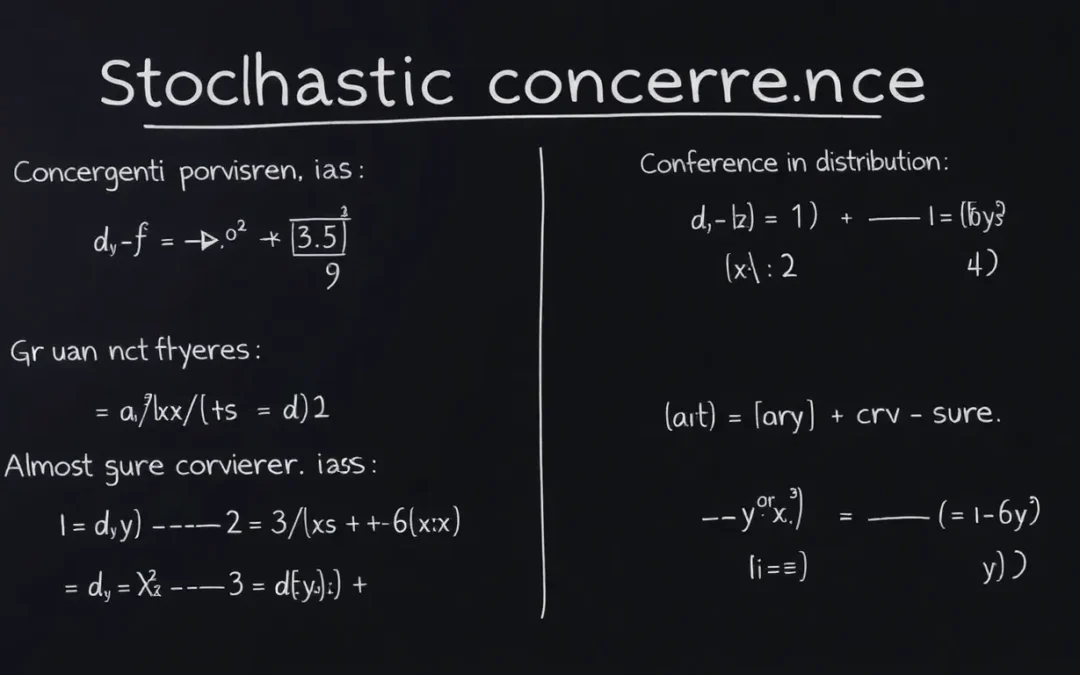
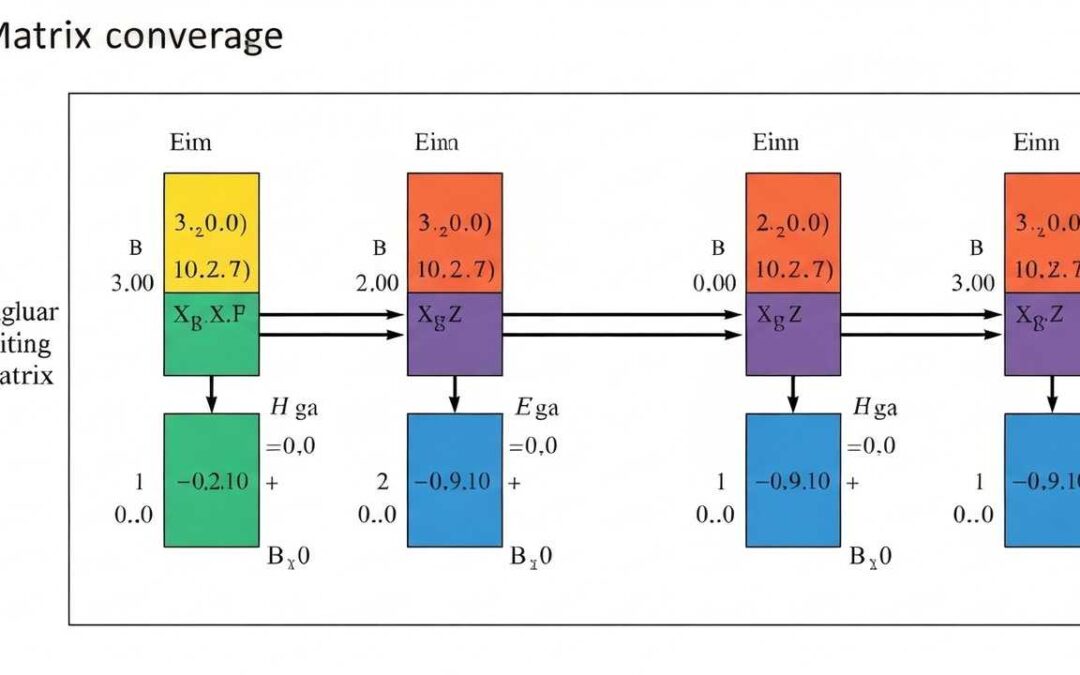


0 Comments